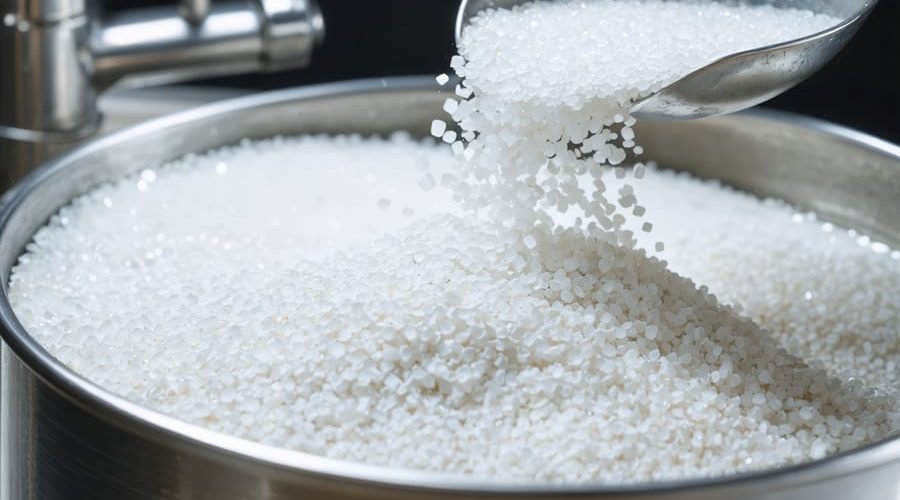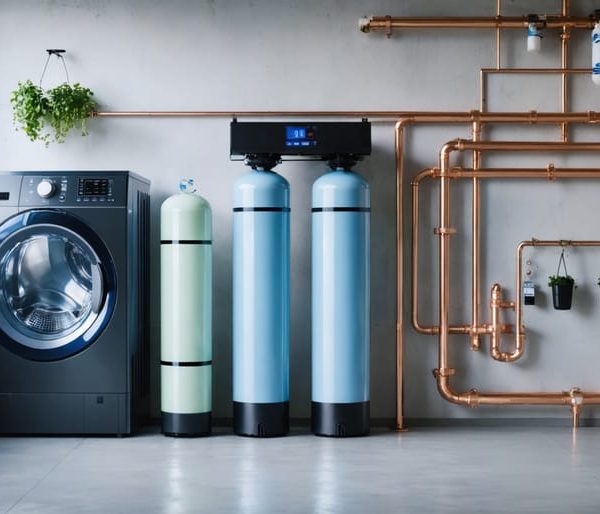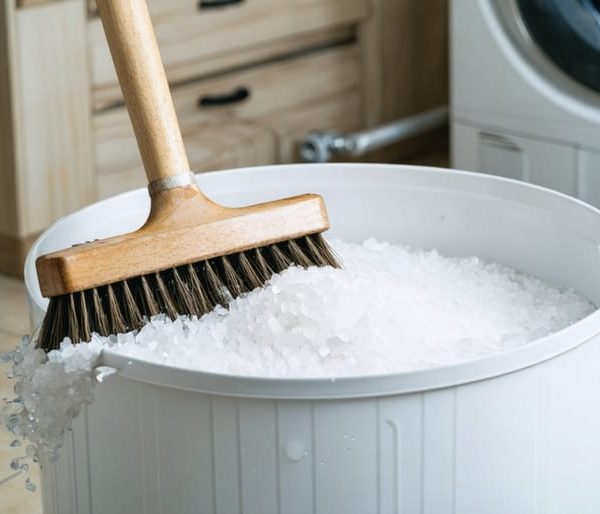Water softeners transform hard water into soft water through **ion exchange**—a chemical process where calcium and magnesium ions (the culprits behind scale buildup and soap scum) are swapped for sodium or potassium ions. Inside your softener’s resin tank, millions of tiny plastic beads carry a negative charge that attracts and traps hardness minerals as water flows through. When these beads become saturated, a concentrated salt solution regenerates them by flushing away accumulated minerals and recharging the beads with fresh sodium ions.
**Understanding this principle reveals why salt quality directly impacts your system’s performance.** Pure, high-grade salt dissolves completely and efficiently recharges resin beads without leaving residue that clogs valves or reduces capacity. Impurities in low-quality salt form sludge at your tank’s bottom, forcing more frequent cleanings and potentially shortening your equipment’s lifespan. The type of salt you choose—whether solar, rock, or evaporated—affects dissolution rates, regeneration efficiency, and long-term maintenance needs. By grasping how ion exchange works, you’ll recognize that your salt isn’t just a supply item; it’s the fuel that keeps your water softener functioning effectively while protecting your investment and ensuring consistently soft water throughout your home.
The Ion Exchange Principle: How Your Water Softener Actually Works
Hard Water Minerals Meet Resin Beads
Inside your water softener tank, thousands of tiny resin beads—each about the size of a grain of sand—work like microscopic magnets for hard water minerals. These specially-designed beads carry a negative electrical charge on their surface, which becomes crucial for the softening process.
When hard water flows through the tank, it brings along unwanted calcium and magnesium ions, the primary culprits behind limescale buildup on your fixtures and dishes. Here’s where the magic happens: these mineral ions carry a positive charge, making them naturally attracted to the negatively-charged resin beads.
Think of it like a molecular handshake. As hard water passes through the resin bed, the positively-charged calcium and magnesium ions literally stick to the beads’ negatively-charged surface. In exchange, the beads release sodium ions (from the salt) into the water—a swap that happens millions of times as water flows through your system.
This ion exchange process transforms hard water into soft water almost instantly. The calcium and magnesium remain trapped on the resin beads while the treated, softened water continues to your home’s plumbing.
Eventually, the resin beads become saturated with hard water minerals and can’t trap any more. This is when your system needs regeneration—flushing the beads with a concentrated salt solution to recharge them and prepare for another softening cycle. Understanding this fundamental process helps you appreciate why salt quality directly impacts your system’s efficiency and longevity.
The Regeneration Cycle: Where Salt Enters the Picture
Over time, those hardworking resin beads become saturated with calcium and magnesium ions—they’re full and can no longer soften your water effectively. This is where salt becomes essential to your water softener’s operation.
During the regeneration cycle, your system creates a concentrated salt brine solution by mixing water with the salt in your brine tank. This highly concentrated sodium solution flows through the resin tank, and chemistry takes over. The abundance of sodium ions in the brine essentially reverses the ion exchange process—the calcium and magnesium ions clinging to the resin beads are displaced and flushed down the drain, while fresh sodium ions attach themselves to the beads.
Think of it as giving your resin beads a rejuvenating reset. The concentrated salt solution strips away the accumulated hard minerals and recharges each bead with sodium ions, preparing them for another cycle of water softening. This regeneration typically happens automatically during low-water-use periods, often in the middle of the night.
Here’s why salt quality matters: impurities in low-grade salt can leave residue on the resin beads or create buildup in your brine tank, reducing efficiency and potentially shortening your system’s lifespan. Cleaner salt means cleaner regeneration, which translates to better performance and less maintenance. For environmentally-conscious homeowners, using high-purity salt also means your system uses less water and operates more efficiently during each regeneration cycle, reducing both your water consumption and environmental footprint.
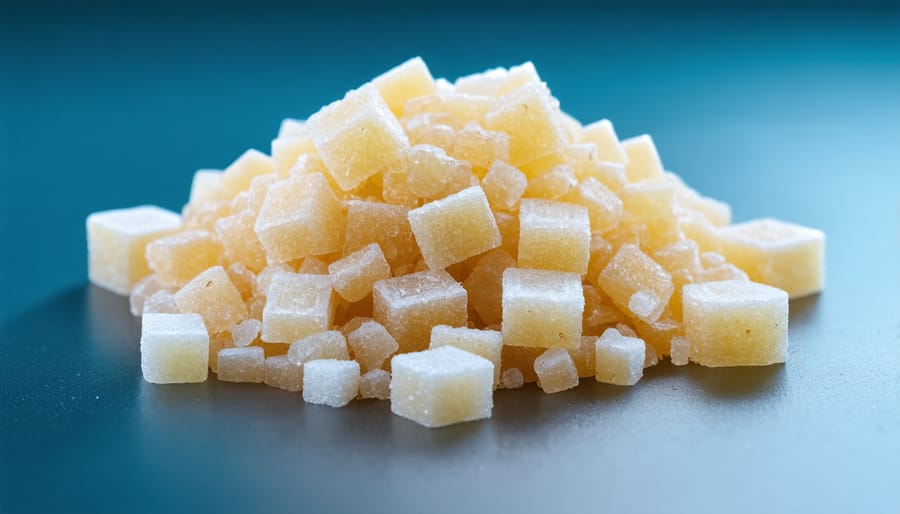
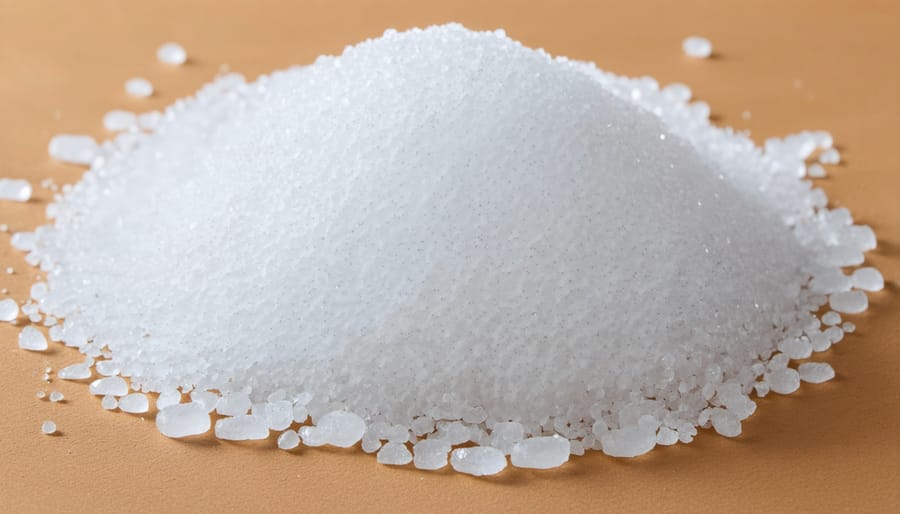
Why Salt Quality Directly Impacts Ion Exchange Efficiency
Purity Levels and Resin Protection
The quality of salt you choose directly impacts how well your water softener’s resin beads can perform their ion exchange magic. Think of resin beads as tiny workhorses that swap calcium and magnesium ions for sodium ions—but they need to stay clean to do their job effectively.
When you opt for lower-grade salt containing impurities like dirt, minerals, or organic compounds, these contaminants don’t simply dissolve during the regeneration cycle. Instead, they leave behind a residue that gradually coats the resin beads. This buildup acts like a barrier, preventing the beads from making direct contact with hard water minerals. Over time, your system’s ion exchange capacity diminishes, meaning fewer hard water minerals get removed with each cycle.
This coating effect creates a domino of problems. Your water softener must regenerate more frequently to compensate for reduced efficiency, consuming more salt and water in the process. The resin bed’s lifespan shortens, potentially requiring expensive replacement years earlier than expected. You might also notice your water doesn’t feel as soft, or you’re dealing with scale buildup again.
Higher-purity salts—typically 99.5% pure or greater—dissolve cleanly without leaving these harmful deposits. While they cost slightly more upfront, they protect your investment and maintain optimal performance. For eco-conscious homeowners, this means less waste, fewer regeneration cycles, and a system that works efficiently for years to come.
Dissolution Rate and Brine Concentration
Not all water softener salts work the same way when it comes to creating the brine solution that regenerates your system. The form your salt takes—whether crystals, pellets, or blocks—directly impacts how quickly it dissolves and how concentrated your regeneration brine becomes.
**Salt crystals** dissolve relatively quickly because of their natural structure and larger surface area. They’re essentially evaporated sea salt or mined salt in their purest form. This faster dissolution rate means your brine reaches the optimal concentration more readily, ensuring effective regeneration. However, crystals can sometimes leave more residue in your brine tank if they contain impurities.
**Salt pellets** are compressed from crystallized salt and dissolve more slowly but uniformly. This controlled dissolution rate creates a consistently strong brine solution over time, which is ideal for most household systems. Pellets also tend to be purer, reducing the likelihood of salt dissolution issues like bridging or mushing that can interfere with your softener’s performance.
**Salt blocks** dissolve at the slowest rate of all three forms. While convenient because they require less frequent refilling, they may not always produce brine concentrated enough for highly efficient regeneration, especially in systems with heavy water usage.
The brine concentration matters because your water softener’s resin beads need a sufficiently strong salt solution to effectively swap out the accumulated hardness minerals. Too weak, and regeneration becomes incomplete. Too strong isn’t necessarily better either—it wastes salt and increases your environmental footprint.
For most homeowners focused on both performance and sustainability, high-purity pellets offer the best balance. They dissolve predictably, minimize waste, and help your system operate at peak efficiency while reducing unnecessary salt consumption.
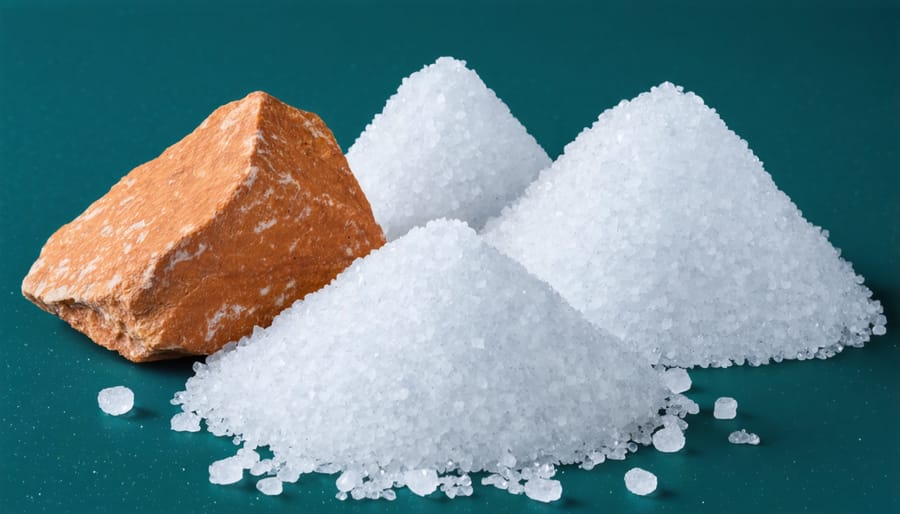
The Three Main Types of Water Softener Salt and Their Performance
Rock Salt: The Budget Option’s Trade-offs
Rock salt offers the most economical choice for water softener salt, typically containing 90-95% sodium chloride. The remaining 5-10% consists of insoluble materials—minerals and sediment that don’t dissolve during the regeneration cycle when your system flushes hard minerals from the resin beads.
These insoluble materials gradually accumulate at the bottom of your brine tank, forming a sludge layer that can interfere with proper brine concentration. Over time, this buildup may reduce regeneration efficiency, meaning your softener won’t clean the resin beads as effectively. You’ll need to manually clean your tank more frequently—typically every 6-12 months versus annually with purer salts.
Rock salt makes practical sense if you have a basic softener system, manageable water hardness levels, and don’t mind the extra maintenance. It’s particularly suitable for vacation homes or properties where water usage is light. However, homeowners with high water demands or premium softener systems should consider the long-term trade-off: while you’ll save upfront, reduced efficiency means higher water waste during regeneration cycles and potentially more frequent servicing. For eco-conscious households prioritizing sustainable water use, investing in higher-purity options often aligns better with reducing environmental impact over your system’s lifetime.
Solar Salt: The Middle Ground
Solar salt strikes an excellent balance between effectiveness and environmental responsibility, making it a popular choice for homeowners who care about both performance and sustainability. With a purity level exceeding 99%, solar salt provides the clean sodium chloride your water softener’s ion exchange process needs to consistently remove hardness minerals like calcium and magnesium from your water.
What makes solar salt particularly appealing is how it’s produced. Rather than energy-intensive mining operations, solar salt is created through the natural evaporation of seawater or brine in large outdoor ponds. The sun does the work, dramatically reducing the carbon footprint associated with production. This eco-friendly manufacturing process aligns perfectly with sustainable living practices while still delivering reliable results.
For the ion exchange process at the heart of your water softener, solar salt’s high purity means fewer impurities entering your brine tank. This translates to cleaner regeneration cycles and less residue buildup on your resin beads—the tiny spheres that actually capture hard water minerals. You’ll typically find solar salt available in crystal or pellet form, both designed to dissolve efficiently during the regeneration phase when your system recharges itself.
While solar salt may cost slightly more than rock salt, its superior purity and environmentally-conscious production make it worth considering for homeowners seeking that middle-ground solution.
Evaporated Salt: Maximum Efficiency
Evaporated salt stands out as the premium choice for water softener systems, boasting an impressive 99.9% purity level. This exceptional purity means virtually no insoluble materials enter your brine tank, which directly translates to cleaner, more efficient resin regeneration. When your softener’s resin beads undergo the regeneration process—where sodium ions replace the accumulated calcium and magnesium—the purer your salt, the more effectively this ion exchange occurs.
Think of it this way: lower-quality salts introduce sediment and minerals that can accumulate in your system over time, potentially reducing efficiency and requiring more frequent maintenance. Evaporated salt’s near-perfect purity eliminates these concerns, keeping your resin bed functioning at peak performance.
From a cost-benefit perspective, evaporated salt typically costs more upfront than rock salt or solar salt. However, it’s often the smartest investment for households with hard water issues. If you’re dealing with very hard water (above 10 grains per gallon), using high-purity salt helps maximize your system’s lifespan and reduces long-term maintenance costs. For smaller households with moderately hard water, the premium might be less critical, though the convenience of less tank cleaning remains valuable.
When selecting the best water softener salt for your situation, consider both your water hardness level and how much effort you want to invest in system maintenance.
Matching Salt Choice to Your Water Hardness and Usage
High-Hardness Water Scenarios
When your water tests above 10 grains per gallon (considered very hard), your softener faces a tougher workload. Here’s why salt purity becomes especially critical: the ion exchange resin beads in your quality water softener system must remove significantly more calcium and magnesium minerals with each cycle. During regeneration, these hardness minerals are flushed away using a concentrated salt solution—but if your salt contains impurities like dirt, minerals, or additives, these contaminants can accumulate on the resin beads over time, reducing their effectiveness.
Higher-purity salts (99%+ pure sodium chloride) ensure that regeneration cycles work efficiently without leaving residue behind. Think of it like washing dishes with clean water versus muddy water—the cleaner your regenerating solution, the better it cleans. For households dealing with very hard water, investing in purer salt options like solar salt or evaporated salt pellets helps maintain optimal system performance, extends equipment lifespan, and reduces the frequency of maintenance cleanings. This eco-conscious choice ultimately means fewer regeneration cycles needed and less salt consumption overall.
Iron and Manganese Considerations
While standard water softeners excel at removing calcium and magnesium, iron and manganese present unique challenges to the ion exchange process. These minerals can accumulate on resin beads differently than hardness minerals, forming stubborn deposits that reduce your system’s efficiency over time.
Iron, particularly in its oxidized form, can coat resin beads with a reddish-brown buildup that blocks exchange sites where calcium and magnesium normally attach. Manganese creates similar issues with dark, sticky deposits. When these minerals are present in your water supply—even at levels as low as 0.3 parts per million for iron—standard softener salt may not provide adequate cleaning during regeneration cycles.
This is where specialized salts with additives become essential. These formulations contain ingredients like citric acid or rust removers that break down iron and manganese deposits during the regeneration process, keeping your resin beads clean and functional. Think of it as the difference between rinsing dishes versus actually scrubbing them—sometimes plain water isn’t enough.
If your water contains noticeable iron staining or testing reveals elevated iron or manganese levels, choosing a salt specifically designed for these conditions helps maintain your softener’s performance and extends the system’s lifespan, ultimately reducing waste and supporting your eco-friendly household goals.
Understanding how your water softener works through ion exchange isn’t just academic knowledge—it’s the foundation for making smarter, more sustainable choices about your home’s water treatment system. When you grasp that sodium or potassium ions literally swap places with hardness minerals, you can see exactly why your salt selection directly impacts system efficiency, longevity, and environmental footprint.
Choosing high-purity salt means fewer impurities accumulating in your brine tank, reducing maintenance headaches and extending your system’s lifespan. This translates to less waste, fewer service calls, and better water quality flowing through your home. Meanwhile, understanding ion exchange helps you evaluate alternatives like salt-free water softener systems that use different technologies for specific water quality goals.
The key to optimizing your water softener performance starts with testing your water hardness. Purchase an inexpensive test kit or request a professional analysis to establish your baseline. Then monitor your system regularly—check salt levels monthly, observe regeneration cycles, and watch for changes in water feel or appliance performance. This ongoing attention allows you to fine-tune salt type and quantity based on your actual household needs rather than guesswork.
By connecting technical understanding with practical action, you’re not just maintaining equipment—you’re making environmentally conscious decisions that reduce waste, conserve resources, and ensure your family enjoys consistently high-quality water for years to come.
